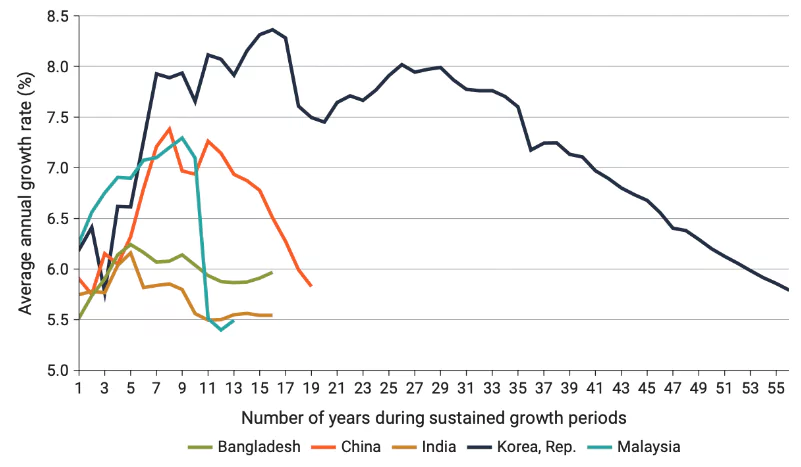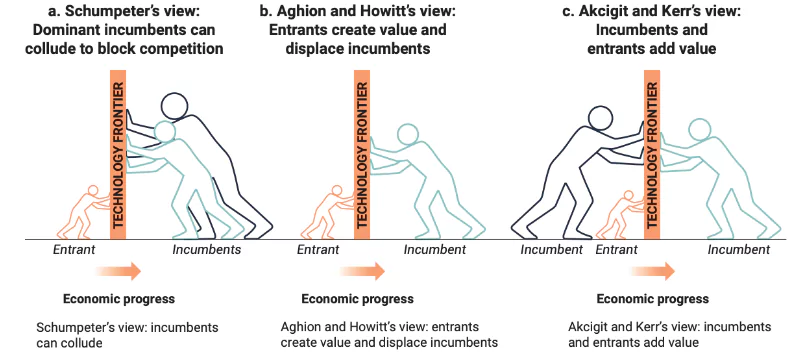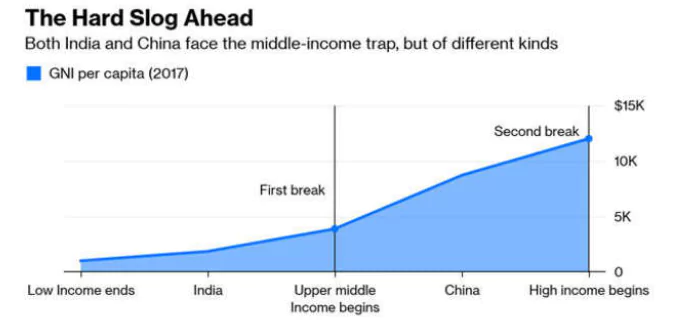Recently, World Bank releases the World Development Report 2024 provides a comprehensive roadmap to enable developing countries to escape the “Middle-Income Trap”
Key Highlights From The Report
Timeline for Economic Growth: China could take 10 years, Indonesia could take 70 years, and India could take as many as 75 years just to reach a quarter of the per capita income of the United States.
World Development Report 2024
- It focuses on the issue of the ‘middle-income trap’.
- Published by: World Bank annually since 1978
- The report chooses a specific aspect of economic development each year. This time the report expressed its concerns about the potential challenges faced by India and China, along with 106 other countries, towards becoming high-income developed countries.
|
- Classification and Disparity: At the end of 2023, 108 countries were classified as middle-income, each with annual GDP per capita in the range of $1,136 to $13,845.
- Disparity: These countries are home to six billion people which is 75% of the global population and two out of every three people living in extreme poverty.
- They generate more than 40% of global GDP and more than 60% of carbon emissions.
- They face far bigger challenges than their predecessors in escaping the middle-income trap:
Enroll now for UPSC Online Course
India’s Growth
- Nominal Rate of 8% till 2047: India needs to keep growing in dollar terms at a nominal rate of 8% till 2047 if it wants to break free from the so-called middle-income trap.
- Challenges: t will have to keep doing it amid growing geopolitical tensions, an inward looking world where globalisation continues to face challenges, and climate changes keep posing new threats to the existing model of growth.
- India’s growth: India grew its economy in dollar terms at around 9% nominal rate during the previous 25 years.
- To maintain almost the same rate of growth with a higher base for the next 25 years needs something special.
|
-
-
- Rapidly aging populations
- Rising protectionism in advanced economies
- Need to speed up the energy transition.
- Growth in middle-income countries is slower than that in countries at other income levels: Growth slowdowns occur more frequently in middle-income countries than in low- or high-income countries.
- Development strategies that served countries well in their low-income phase—capital investment, yields diminishing returns.
- Countries with weaker institutions and especially those with lower levels of economic and political freedom—are susceptible to slowdowns at even longer levels of income.

- Challenges for Middle Income Countries:
-
- Geopolitical Tensions: Foreign trade and investment are in danger of becoming constricted by geopolitical tensions
- Populism: It is shrinking the room for governments to act.
- Rising Debt and Adverse Demographics: They are crowding out private investors and reducing public investment.
- Accelerating Climate Action: It will require large investments in infrastructure and regulatory reforms that may stall productivity
- Value Creation: Both incumbents and entrants can create value.
- Incumbents: They are established companies that have been operating in a market for a long time. They typically have significant market share, established customer bases, and well-developed distribution channels.
- Entrants: They are companies or individuals that are newly entering a market. These entrants may bring innovative products, services, or business models that challenge the status quo.
|
-
- Incumbents bring scale. They can compete with entrants in the market to jointly expand a country’s technological capabilities, thereby moving the country closer to the global frontier.
- Entrants bring change—enterprises with new products or production processes, workers with new skills and ideas, or energy sources such as renewables that embody new technologies. By doing so, they expand a country’s technology frontier.
- Implication of having both incumbents and entrants as value creators: Policy makers will have to stop relying on superficial measures of structural efficiency such as firm size, income inequality, and energy sources.
- Imperative for today’s middle-income economies is “efficiency”in the use of capital, labor, and energy.
Check Out UPSC CSE Books From PW Store
Interactions between entrants and incumbents set the pace of creative destruction

About Middle-Income Trap
- About: A middle-income trap is a scenario where the country’s economy is unable to transition to the higher per-capita income levels.
- Low-income countries often tend to transition faster to middle-income levels, driven by low wages, cheap labour and basic technology catch-up. However, only a few countries manage to achieve high-income status.
- For Example: Latin American and Middle Eastern countries, historically these countries suffered middle-income traps for at least four or five decades.
- According to a World Bank Report: Out of 101 middle-income countries in 1960, only 13 countries achieved high-income status by 2008 based on per capita income level relative to the United States.
- Way to Improve: After rising to a matured middle-market economy, policymakers need to be innovative, strengthen institutional capacities and look for renewed sources of growth rather than depending on the traditional growth engines to avoid such traps.

Challenges India Faces
- Structural Economic Constraints:
- Limited Industrialization: Despite efforts, India has not undergone the kind of industrial transformation seen in East Asian economies. Manufacturing remains a relatively small part of the economy compared to services.
- Agricultural Productivity: A large proportion of the workforce is still employed in agriculture, which is marked by low productivity due to small landholdings, inadequate infrastructure, and insufficient mechanization.
- Human Capital Deficiencies:
- Education and Skills Gap: The Indian education system has struggled to provide the quality education needed to create a skilled workforce ready for a modern economy.
- Health Concerns: Public health challenges, highlighted by the COVID-19 pandemic, stress the need for a stronger healthcare infrastructure.
- Innovation and Research:
- R&D Expenditure: India’s spending on research and development is low compared to other major economies, which stifles innovation.
- Patent Registrations: There is also a low rate of patent registrations, reflecting upon the inadequate emphasis on research and innovation.
- Infrastructure Bottlenecks:
- Inadequate Infrastructure: Poor logistics, energy, and digital infrastructure can hamper productivity and discourage investment.
- Financial Sector Issues:
- Access to Credit: Small and medium-sized enterprises (SMEs) often face difficulty in accessing finance, which restricts their ability to grow.
- Non-Performing Assets: The banking sector has been struggling with a high level of non-performing assets (NPAs), reducing its lending capacity.
- Demographic Dividend or Burden:
- Youth Unemployment: High unemployment rates among the youth could turn the potential demographic dividend into a demographic burden.
- Regulatory and Governance Concerns:
- Red Tape: Bureaucratic hurdles and red tape can be a significant impediment to doing business in India.
- Corruption: Transparency issues and corruption also affect investor confidence and economic efficiency.
Check Out UPSC NCERT Textbooks From PW Store
Way Forward For India To Avoid Middle Income Trap
- Growth in middle-income countries different from that in countries at other income levels:
The “3i strategy”
Depending on their stage of development, countries need to adopt a sequenced and progressively more sophisticated mix of policies:
- Low-income countries: It can focus solely on policies designed to increase investment—the 1i approach.
- Lower-middle-income countries: It must shift gears and expand the policy mix to 2i, investment + infusion.
- Upper-middle-income countries: It needs to shift gears yet again—to 3i: investent + infusion + innovation.
|
-
- Successful middle-income countries will have to engineer two successive transitions to develop economic structures that can eventually sustain high-income levels.
- First transition: It is from a 1i strategy for accelerating investment to a 2i strategy focusing on both investment and infusion in which a country brings technologies from abroad and diffuses them domestically—a process broadly applicable to lower-middle-income countries.
- Second transition: It is to switch to a 3i strategy, which entails paying more attention to innovation—a process more applicable to upper-middle-income countries.

‘2i’ Not Enough For India
- Talking about India, a lower-middle-income economy with a per capita income of $ 2,390 in 2022, the suggestion to focus on the ‘2i’s of investments and infusion of technology is not enough.
- Considering India’s demographic dividend: It is the time bracket that India can hardly afford to lose.
- R&D: It should focus on innovations, research and development; it has good institutions and an able human capital to begin with.
- Upgradation: It has to be admitted that institutions should be upgraded to meet world standards, and robust human resource development is imminent in India.
- Youth & PPA: Indian youth is aspirational, and public-private-academia (PPA) trilateral convergence as was prescribed by this year’s economic survey as well could better harness this potential of India.
|
- Merit must be rewarded—and vested interests must be disciplined.
- The handful of countries that have made speedy transitions from middle- to high-income status have done so by disciplining vested interests, building their talent pool, and modernizing policies and institutions.
- Since 1990, only 34 middle-income economies have managed to shift to high-income status — and more than a third of them were either beneficiaries of integration into the European Union (EU), or of previously undiscovered oil
- Today’s middle-income countries can do the same:
- Discipline vested interests: Powerful incumbents (large corporations, state-owned enterprises, and powerful citizens) can add immense value, but they can just as easily reduce it.
- Governments must devise mechanisms to discipline incumbents through competition regimes that encourage new entrants without either coddling small- and medium-size enterprises or vilifying big corporations.
- Reward merit: Middle-income countries have smaller reservoirs of skilled talent than advanced economies and are also less efficient at utilizing them. So they will have to become better at accumulating and allocating talent.
- Capitalize on crises: Cheap, reliable energy has long been a cornerstone of rapid economic development. But prospering while keeping the planet livable will now require paying greater attention to energy efficiency and emissions intensity.
- Climate change and other exigencies can provide opportunities to forge the consensus needed for tough policy reforms.
- Highest Socio-Economic Inequalities: So it is the onus of our policymakers to ensure that India’s quest for ‘Vikisit Bharat’ by 2047 should not be limited to enclaves but should be made inclusive and broad-based.
- Infrastructure Development: Accelerating investment in infrastructure, including roads, ports, electricity, and digital networks, through mechanisms like public-private partnerships (PPP).
- For example, the Smart Cities Mission is an initiative that aims to develop sustainable and inclusive urban solutions.
- Improving Governance: Streamlining administrative processes and improving regulatory frameworks to reduce red tape.
- Taking stringent measures against corruption to enhance transparency and accountability in governance.
- Reports of Western institutions: They are often accused of presenting the data and facts such that they may perpetuate the myth of the West’s superiority and invisibility.
- India must not be demotivated and should apply the aforesaid strategy of all three ‘i’s to ensure better and more equal opportunities for its citizens while upgrading the living standards of its people and enhancing the capabilities of its human resources.
Enroll now for UPSC Online Classes
Conclusion
Avoiding the middle-income trap will require India to implement a multifaceted strategy, encompassing economic, educational, and governance reforms. With targeted policies and a commitment to structural reforms, India can pave the way for sustained growth and development, propelling it towards the high-income economy status.
![]() 7 Aug 2024
7 Aug 2024




